This PSEB 7th Class Computer Notes Chapter 5 Microsoft Word Part-III will help you in revision during exams.
PSEB 7th Class Computer Notes Chapter 5 Microsoft Word Part-III
Introduction
We can do a lot of work or formatting on the picture in our Word document. Also work in page layout, background etc. and then review our work and print it.
Format Picture Tool
The Format Picture toolbar in MS Word gives us all the options to format the picture. You can do any kind of formatting with the help of picture tool bar such as increase the size of the picture, change the color of the picture, change the background of the picture, change the brightness of the picture, etc. The image toolbar on the ribbon only appears when we select an image.
The Picture Format tool bar has 4 groups like Adjust, Picture Style, Arrange, Size. These four groups provide different types of formatting options for formatting an image.

Adjust Group:
You do not need to use additional picture editing software to create high quality images for your document. Instead, you can use Adjust tools to correct and improve your photos.
1. Correction: This command is used for brightness, sharpness, softness and adjustment of images for better printing or screen presentation. Steps to use this command are as ahead:
(a) Select photo.
(b) In the Format tab, click on the Correction option from the Adjust group. A drop-down menu will now open.
(c) From this menu, select sharpen/Soften and brightness Contrastsettings according to toyour needs.
To make these settingsmore detailed, go toPicture Format >> Corrections >> “PictureCorrections Options”options. The FormatPicture sidebar appears. This allows you to provide special settings for Sharpness, Brightness and Contrast.
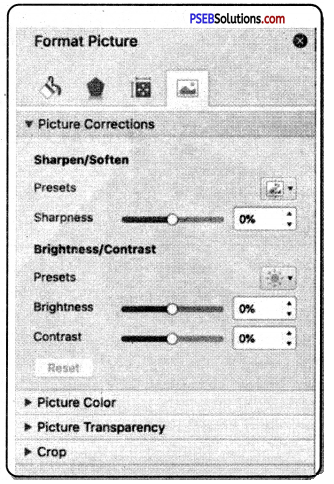
2. Picture Color: Microsoft Word allows you to control the color and tone of your picture and you can repaint the whole picture for special effects.
Steps to change the picture color are as follows:
(a) Select picture.
(b) In the Format tab, click on the Color option from the Adjust group. A drop-down menu will open.
(c) In this menu there are 3 options:
- Color Saturation: This controls how bright the colors are in the image.
- Color Tone: This controls the temperature of the color, from cool to warm.
- Recolor: This controls the overall color of the image. Use this option to make the image black and white or grayscale, or to colorize it with a different color.
(d) Choose any of the options as per your need.
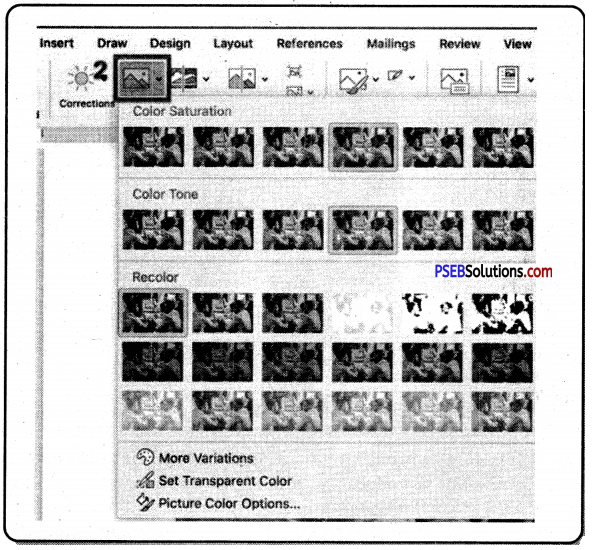
There are three more options in this dropdown menu which are as follows:
- More Variation: Repaints the image with a different color than the options provided.
- Set Transparent Color: Makes some colors transparent so that the background color is visible.
- Picture Color Options: The format opens the picture sidebar, where you can customize the settings for color saturation, tone and recolor.
3. Artistic Effect: This option can be used to add artistic effects to a picture. Using this option, the picture looks like a sketch or painting.
Below are the steps to add Artistic Effects to the photo:
(а) Select picture.
(b) In the Format tab, click on the Artistic Effects option from the Adjust group. A drop-down menu will appear.
(c) To preview the style, place your mouse pointer over the picture styles.
(d) Now choose the style according to your need.
![]()
Compress Picture:
With this button the image can be compressed. To reduce the size of documents, pictures can be reduced in storage size. You can change the resolution of an image or delete a cropped part of an image.
The steps to compress a picture are given below:
(a) Select the picture.
(b) In the Format tab, click on the Compress picture option from the Adjust group.
(c) Now a Compression Settings dialog box will open.
(d) If you want to print the picture, click on the Print (220 ppi) option.
(e) If you want to reduce the size of the file to e-mail, click on the E-mail (96 ppi) option.
(f) If you want to upload the file to a webpage or projector, click on Project Options.
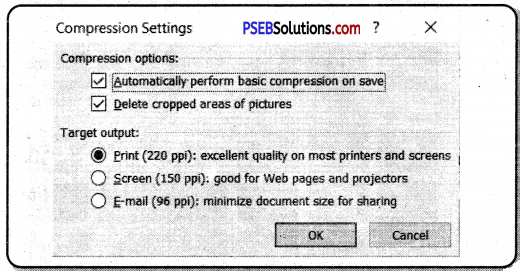
Change Picture: Sometimes we need to change the picture in our document, we can easily replace the already exist picture with a new picture with the help of “Change picture”. “Change picture” command replaces the existing picture into a new picture while preserving the formatting and size. The steps to change the photo are as follows:
(а) Select the picture you want to change.
(b) In the Format tab, click on the Change picture option from the Adjust group.
(c) The Insert dialog box opens.
(d) Select a new image from this dialog box and click the Insert button.
Reset Picture: If you want to remove all formatting changes to a picture in the document, “Reset Picture” command will be used. This button is used to undo all formatting changes made to the picture and restore it to its original format.
(а) Select the picture.
(b) In the Format tab, click on the Reset picture option from the Adjust group.
7. Remove Background: This option is used to automatically remove unwanted parts of an image. Areas to remove or keep can be marked in the picture. Following are the steps to remove the background of a photo:
(a) Select the image from which you want to remove the background.
(b) Click the “Remove Background” option from the Adjust group in the Format tab.
(e) Now the default background area will be marked with magenta cokr, while the foreground will remain its natural color.
(d) If the default area isn’t correct, go to Background Removal > Picture Tools and do one or both of the following:
if parts of the picture that you want to keep are magenta, select
“Mark Areas to Keep” option and use the drawing pencil

to mark the areas on the picture that you want to keep.
To remove more parts of the picture, select “Mark Areas to Remove” option and use the drawing pencil

to mark those areas.
When you’re done, select “Keep Changes” or “Discard All Changes”.
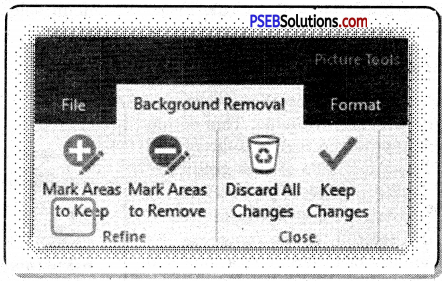
Picture Style Group
Picture Styles Gallery offers many preset styles that make it easy for you to add borders and special effects with one click.
1. Picture Style Gallery : This field provides a list of different formats that can be applied to an image. To see what each style will do, just move the mouse pointer over each style. To apply the style on a picture steps are as follows :
(a) Select the photo whose style you want to change.
(b) On the Format tab, in the Picture Styles group, click any style you like.

2. Picture Border: Use this command to change the color, width, or line style of the border of the image. Steps to add border as follows:
(a) Select the image to which you want to add a border.
(b) On the Picture Format tab, in the Picture Styles gallery, select Picture Border command. A drop-down menu will appear.
(c) From this menu select color for border line.
(d) Select weight (thickness) of boarder line.
(e) Select whether the line of the border is dashed.
3. Picture Effects: Click this button to add visual effects to the picture such as shadows, 3-D effects, and glows. Steps to add an effect to a picture are as follows:
(а) Select the picture for which you want to add or change an effect.
(b) Under the Format tab, in the Picture Styles group, click Picture Effects command.
(c) A drop-down list will appear. From this menu select appropriate effect for image.
Arrange Group
In this group, all the options that determine the position of the text are available. This option determines which side of the text is to be placed on the picture. The commands of this group are Text Wrapping, position, align, rotate etc.
1. Picture Position: This button is used to change the position of the image on the page. A gallery of different locations will be displayed. You can also click on the “More Layout options” link to display additional options.
(a) Select the item whose position you want to change.
(b) Click on the “Position” option from the Arrange group.
(c) Choose the right place for your object as shown in the picture.
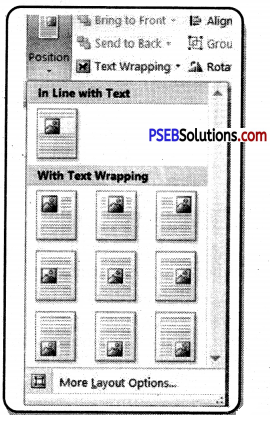
2. Text Wrapping: This feature is used to apply wrapping to an image. When wrapping is applied, text can be typed around the image. Make it easy to move images from one place to another in a document. To apply the text wrapping on the image follow these steps:
(a) Select the image which you want to apply wrapping.
(b) From the Picture Tools tab, in the Arrange group, click on the “Text Wrapping” option.
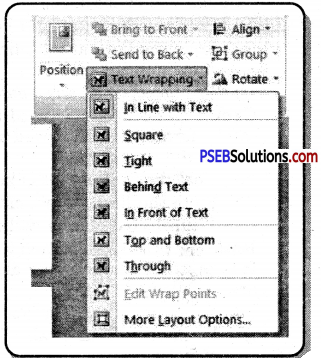
Do one of the following:
(a) Click “Square” command to type the text around the border of your picture.
(b) Click ‘Tight” command to type text around a clip art image or an irregularly shaped image.
(c) Click “Behind Text” command to display the text on the image.
(d) Click “In Front of Text” command to display the image on the text.
(e) Click “Top and Bottom” command to place the image on your line. (/) Click “More Layout Options” command for more layout Options. From this dialog box, specify the distance between the text and the image.
3. Bring Forward: Use this button when an image is behind another image and needs to be highlighted. Click on the list arrow to select Bring Forward, Bring to Front, or Bring in Front of Text options.
4. Send Backward: When an image appears on top of another image and needs to be moved to the back of the image, click this button. Click the list arrow to select Move Backward, Move Back., or Back to Text.
To bring an object to the front or back, steps are as follows:
(а) Select an object. The Format tab will appear.
(b) From the Format tab, click the “Bring Forward” or “Send Backward” drop-down box.
(c) From the drop-down menu, select “Bring to Front” or “Send to Back”.
(d) The objects will reorder.
5. Align Objects: This option is used to align a group of images at the top, bottom, right, or left position. If only one image is selected, the image will be arranged to the specified location on the page.
To align two or more objects, steps are as follows:
(a) Hold the Shift (or Ctrl) key and click the objects you want to align.
(b) From the Format tab, click the Align command and select one of the six alignment options.
(c) The objects will align based on the option you selected.
6. Group: This option is used to combine groups of images so that they can be formatted and moved as an image. To group objects, steps are as follows:
(a) Hold the Shift (or Ctrl) key and click the objects you want to group.
(b) From the Format tab, click the Group command and select Group.
(c) The selected objects will now be grouped.
7. Rotation: Click this button to rotate the image to a different orientation. It is possible to specify the degree of rotation. To rotate an object, steps are as follows:
(a) Select an object. The Format tab will appear.
(b) From the Format tab, click the “Rotate” command. A drop-down menu will appear.
(c) Select the desired Rotation option.
(d) The object will rotate.
![]()
Group
This group provides the option to resize the photo and remove unwanted parts.
1. Crop: Crop button is used to delete the unwanted part of an image. When you crop an image, an unselected part of the picture is removed. Steps to crop the image are as follows:
(a) Select the image you want to crop. The Format tab appears.
(b) On the Format tab, click the Crop command.
(c) Black handles will appear around the image. Click, hold and drag a handle to crop the image.
(d) Click the Crop command again. The image will be cropped.
2. Height: To change the height of the image, enter a size in the box or click the spinner arrow to change the height.
3. Width: To change the width of the image, enter a size in the box or press the spinner arrow to change the width.
Page Layout Tab:
This is the third tab of the ribbon. This tab allows you to control the look of your document, means you can change the page size, margins, line spacing, indentation, documentation, orientation, etc. The Page Layout tab contains five sets of related commands; Manage themes, page setup, page backgrounds,

Page Setup Group
With the help of this group, we can use margins, position, size, columns, etc. to improve the structure of our document.
1. Margins: A margin is the space between the text and the edge of the page. By default, a new document’s margins are set to Normal, which means it has a one-inch space between the text and each edge. Depending on your needs, Word allows you to change your document’s margin size. Steps to Format Page Margins:
(a) Click on the “Page layout” tab.
(b) Click on the Margins command. A drop-down menu will appear. By default “Normal” option will be Select.
(c) Click on any Pre-defined margin.
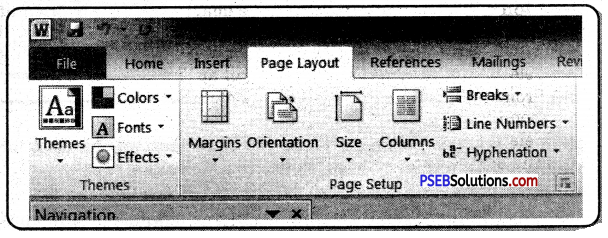
Steps to Use Custom Margins:
(a) Click on “Margins” from the Page Layout tab and select “Custom Margins”.
(b) Page Setup dialog box will appear.
(c) Adjust the margin size for ‘ each side of the page and click Ok.
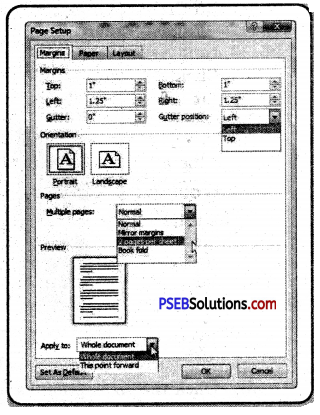
2. Orientation: To change the position of a document from a portrait to a landscape, click this button. To change the position of the page, steps are as follows:
(a) Select the Page Layout tab.
(b) In the Page Setup group, click on the “Orientation” command.
(c) Click “Portrait” or “Landscape” to change the position of the page.
Landscape format means the page is horizontal, while portrait format means it is vertical.
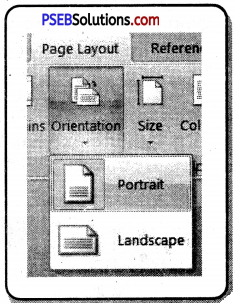
3. Size: Click this button to resize the page that will be used for the document. To resize the page, steps are as follows:
(a) Select the Page Layout tab.
(b) Click on the “Size” command and a drop-down menu will appear.
(c) The current page size will be highlighted in this list.
(d) Click the size option as you want.
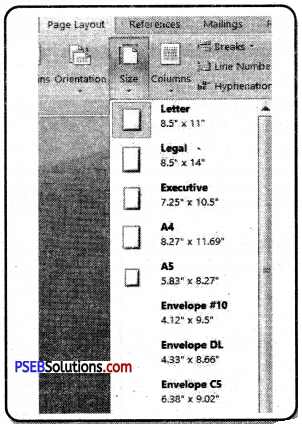
4. Columns: This button is used to split the selected text into two or more columns in a document. A gallery of different column formats is available in this command. To split the text into columns, steps are as follows:
(a) Select the Page Layout tab.
(b) Click on the “Columns” command and a drop-down menu will appear.
(c) Select the number of columns for text.
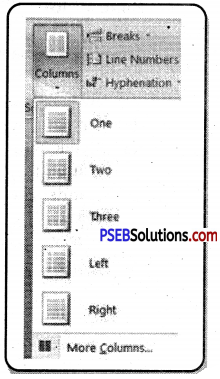
Page Background Group
From this group you can choose watermarks, page colors and borders for your document.
1. Watermark: It is just like a stamp. It is used for confidential documents. A watermark is an image that appears blurred behind the text on a page. The steps to add a
watermark to the docu¬ment are given below:
(a) Open the document to which you want to include the water-mark.
(b) Click the Page Layout tab and then click the “Watermark” button to display a list of standard watermark options.
(c) You can select any available standard watermark by clicking on it. This will apply to all pages of the document.
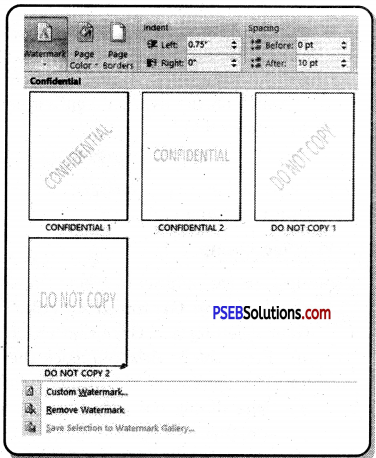
2. Page Color: With the help of this option we can apply different colors, textures and pictures to the background of the page in our document. Steps to add background color or texture are as follows:
(a) Click on “Page color” command in the Page Background group from the Page Layout tab.
(b) A drop-down menu will appear.
(c) Choose one of the following options from this drop-down menu:
- To apply the background color click any color from “Theme Colors or Standard Colors”.
- To apply the texture, Gradient, pattern and pictures into the background, click “Fill Effects” option.
- A Fill Effect dialog Box will appear. Select appropriate design for you background. ‘
3. Page Border: Page borders are used to set borders around the page. Here we can design our page border.
(a) Click on the “Page Borders” option in the Page background group, the Page border dialog box appears.
(b) In the “setting” list, we can choose the border of our choice.
(c) In “Style” list, we can choose style for the line as per our choice. id) Click on the arrow in “Color” drop-down list and select a border color.
(e) Click on the arrow in “Width” drop-down list and select the width of the border.
(f) If we want to use clip art instead of borders in Style, click on the arrow that appears under Art and select a border graphic.
(g) To continue, click on the arrow that appears under “Apply to” and click on the available option as per your requirement.
(h) Click on OK.
![]()
Review
In the Review tab we can see features like Spelling & Grammar, Word Count, “Translatipn and Language”.
Proofing Group
Proofing features help us to create flawless professional documents.
1. Spelling and Grammar Check:
To do Spelling and Grammar check, steps are as follows:
(a) From the Review tab, click the Spelling & Grammar command.
(b) The Spelling and Grammar dialog box will appear.
(c) This dialog box offer one or more suggestions for spellings and grammatical errors.
(d) You can select a suggestion and click “Change” to correct the error.
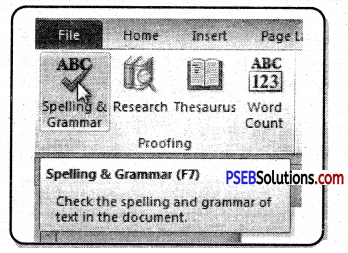
2. Word Count: Word Count is a feature that allows us to determine the number of words, letters and paragraphs in our document. We can also find this number in the status bar at the bottom of the window. Just click the “Word Count” command from proofing group on Review tab.
Printing Documents
Once you’ve created your document, you may want to print it to view and share your work offline. It’s easy to preview and print a document in Word using the Print option.
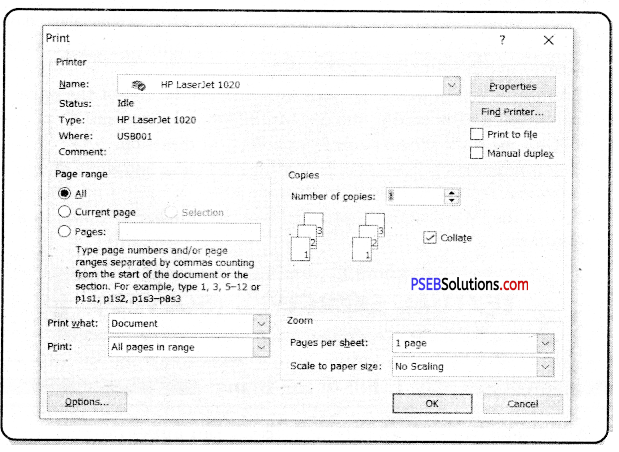
(a) On the File tab or Office button, click Print command.
(b) A print dialog box will appear.
(c) In the “Name” drop-down list select the name of you printer.
(d) In the “Copies” box, enter the number of copies you want.
(e) In “Page Range” option select “All” option if you want to print all pages of your document.
(f) If you want particular page to print then click “Pages” radio button and type page number in the box.
(g) Now click “Print” option. Your document will be print.
Note:
- When we click on the picture, the “Picture Tools Format tab” appears. The color option has three categories — color saturation, color tone, Re-color.
- In MS Word File size can be reduced by compressing images, reducing resolution and deleting cropped areas.
- The Reset Picture option eliminates the formatting and editing of the selected image.
- The Picture Border option determines the color, width and line style of the outline for the selected picture.
- Picture effect adds visual effects to the picture such as shadows, 3-D effects, and glows.
- Wrap text changes the way the text is wrapped around the selected object. Crop option helps in cropping and removing unnecessary parts of the picture.
- Orientation Specifies the portrait or landscape format of the page. Landscape means setting the page in horizontal direction.
- Portrait means setting the page in a vertical direction.
- Spelling errors in words are indicated by a red wave line while grammatical errors are represented by a green wave line.
- We use the “Word Count” option to find the number of words in a Word document.